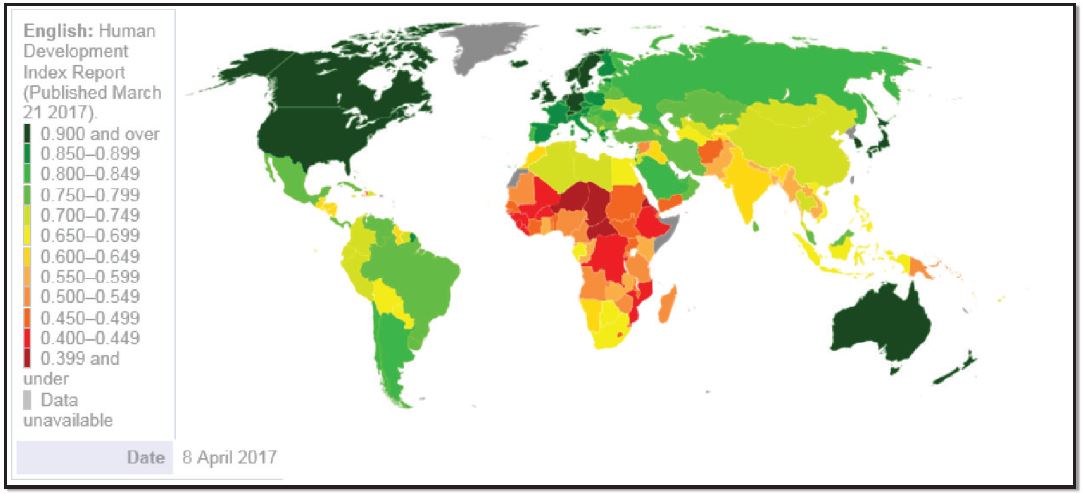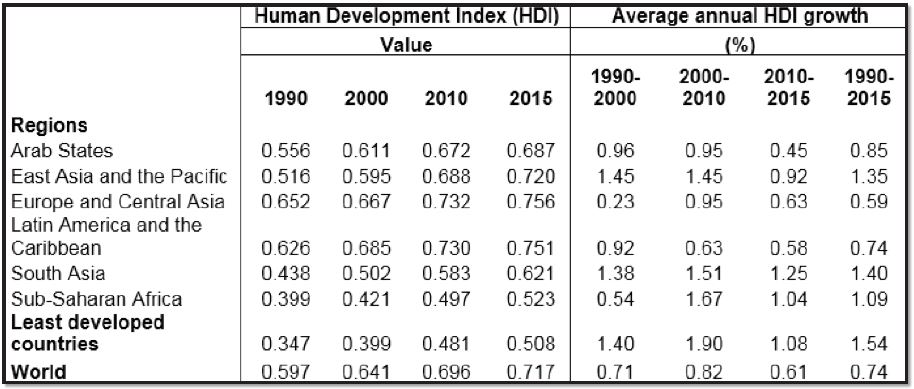81 9.5 NEW MODELS OF DEVELOPMENT
9.5.1 Is There More to Life Than Money?

Figure 9.11 | Human Development Index (Based upon 2016 Human Development Report)
Author | User “Happenstance”
Source | Wikimedia Commons
License | CC BY SA 4.0
This may seem like more of a philosophical question than one you’d find in a geography textbook, but it’s an important one to consider. In the previous section, we learned that the end-point of development is to arrive to a state of high mass consumption relying primarily on indicators of wealth, income, and production to evaluate one place compared to another. Do you think this a fair assessment or are there other ways to gauge development? Think about some of the things that make you feel good or bad about any particular place. Does it have good parks, safe roads, low levels of traffic, or lots of fun things to do? While some of those things are connected to income and wealth, some markers of development do not necessarily have to be connected to wealth.
Indian economist and Nobel Prize winner Amartya Sen argued that our understanding of development needed to be dramatically altered to include a capabilities approach to measuring, encountering, and improving people’s lives. In his book ‘Development as Freedom’, Sen argues that abject poverty comes from a lack of rights and the absence of freedom that are very different from simplistic notions wealth and poverty. For example, a country that produces a lot of oil like Saudi Arabia may demonstrate high GDP growth, but if it doesn’t positively affect the lives of most people in the country, then the GDP is not improving people’s lives in a meaningful way. As obvious as it may sound today, this transformative thinking drove the United Nations to redefine thinking on development as the organization unveiled its first annual Human Development Report (http://www.hdr.undp.org) in 1990, which incorporated a brand new index, called the Human Development Index (HDI) (Figure 9.9). Instead of relying solely on income, the index is derived from indicators of 1) life expectancy, 2) adult literacy, 3) school enrollment, and 4) income to provide a meaningful comparison for almost all countries (a few countries like North Korea choose not to participate). The index provides reason for optimism in that 105 countries are now categorized as ‘very high’ (51 countries) or ‘high’ (54) human development with an HDI of .70 or higher.
You can view the entire list of countries here: http://hdr.undp.org/en/composite/trends, and the regional trends over time are included in Figure 9.10, which shows that the areas with the greatest improvement since 1990 have been East Asia and South Asia. Most notably, China moved from low human development to high and India moved from low to medium during the short period from 1990-2015. Sub-Saharan Africa contains the majority of those with the lowest levels of human development, but nearly every country experienced persistent improvement since 1990. Moreover, developing countries everywhere have seen improvements in educational access and life expectancy during the past 50 years. HDI helps us to quantify those improvements over time. One final point about this index is that some countries do a very good job of providing human development, in spite of low income. Find Mexico and Cuba on the map, for example. In both countries, incomes are low, but life expectancy is high. In the case of Cuba, life expectancy is higher than it is in the U.S. Cuba has followed a protectionist strategy for several years, which has limited financial growth, but its provision of healthcare and education gives it a higher HDI than would otherwise be predicted. Meanwhile, countries like Kuwait and others in the Middle East enjoy high incomes but lower levels of development when measured by the index. HDI also has its limitations since it uses only 4 indicators. Can you think of some other measure that might be meaningful? Some examples might be gender empowerment, levels of inequality, or simply quality of life. Other indexes measure such things, and access to the Internet or to modern sanitation systems. Among those living in rural areas of India, for example, only one quarter of the population has access to a working toilet. The Population Reference Bureau (http://www.prb.org/DataFinder) collects data on these and other indicators by country that are readily accessible. You are encouraged to check out the website to find out more of these!
It’s also important to keep in mind that differences within countries can be very stark. People living in Shanghai, China, for example enjoy a standard of living very similar to the average Italian. Meanwhile, rural dwellers in that country are not much better off than an average person from Sub-Saharan Africa. Just as many rural residents in Tennessee, Mississippi, and West Virginia struggle with access to basic health care and have unemployment rates much higher than in other parts of the U.S. The small country of Bhutan has taken a novel approach to measuring its own development by considering one factor above all others – happiness. Rather than measuring GDP, it closely monitors gross national happiness as a barometer of the spiritual, physical, social and environmental health of its citizens and natural environment. As stated by the Minister of Education, “It’s easy to mine the land and fish the seas and get rich. Yet we believe you cannot have a prosperous nation in the long run that does not conserve its natural environment or take care of the wellbeing of its people.” As you may have noticed, none of the indicators of development presented in this chapter take into account the well-being of the environment or the long-term cost of development. As people become wealthier, they consume more of the earth’s resources. The Bhutan model might seem a little strange to the average American student, but it is one of the few models that takes seriously the notion of environmental sustainability as a component of development.
9.5.2 What Is Microfinance?
Inherent in all forms of development strategies is the importance of money. Previous sections described how the World Bank and the IMF offer development assistance to developing countries. Both of those entities are limited to relatively large-scale projects, however. In recent decades a new form of development assistance has emerged that has proven much more impactful at the local level. The term micro-finance refers to all of financial services normally available through a bank to the wealthy around the world. These include credit cards, short-term loans, interest bearing accounts, and financial insurance. Something as simple as a credit card that allows for a college student to buy books (not this book, however!) can be the difference between staying and leaving college. Small-scale farmers in less developed countries are at constant risk when they do not have access to such credit. With even a very small loan, or micro-loan (e.g. $500), hundreds of millions of farmers can increase their income significantly. If you sell milk, but you only own 3 cows, imagine what you could do with 6 cows! Large-scale development programs don’t offer such things to individual farmers, but new programs and websites are doing exactly that. Perhaps most well-known among these is Kiva.org (http://kiva.org). What started as a small endeavor to match lenders and borrowers by 2 people has morphed into a major provider of loans to more than 100,000 people in 2016, while raising nearly $150 million. Most incredibly, the repayment rate of loans given to the poorest of the poor stands at 97%, an astounding accomplishment.
9.5.3 What Does the Future Hold For Development Around The World?
Predicting the future is always risky. Climate change, emergent untreatable diseases, and massive political upheavals have historically altered the course of history beyond anyone’s imagination. Those caveats aside, the immediate future is expected to be a good one when measured by human development index. As total fertility rates decline across all of the developing world, women’s empowerment will also increase. As more women enter the workforce globally, family incomes are expected to continue to rise. The overarching story of the 20th century was that life expectancies skyrocketed, infant mortality rates declined, and the spread of many communicable diseases was curtailed. Economists argue that, as more countries increase their connectivity to the global system via trade, that the wealth of everyone increases. As hundreds of millions of farmers left the countryside in China and India to seek manufacturing jobs, levels of development increased dramatically. Many predict that the same spatial pattern will occur in African and in other parts of the world in the coming decades as manufacturers seek new markets and new, lower cost labor deep into the 21st century. Many of the improvements worldwide are directly connected to technological improvements. Anyone with an Internet connection in 2018 has access to more information, imagery, and knowledge than average people had throughout their entire lifetime even just one generation ago. As globalization allows for the free flow of information, commerce, currency, and ideas, there is also an increased risk that dangerous things travel along those same routes. The dark web makes for easy illicit exchanges of drugs, weapons, stolen credit cards, human trafficking victims, and all sorts of other horrible things. The challenge for development in the future clearly lies in balancing the risks and benefits of a world that has experienced such a massive time-space compression in such a short period of time.

Figure 9.12 | Human Development Index by Region and Time Period
Author | United Nations Development Programme
Source | United Nations Development Programme
License | CC BY SA 3.0
